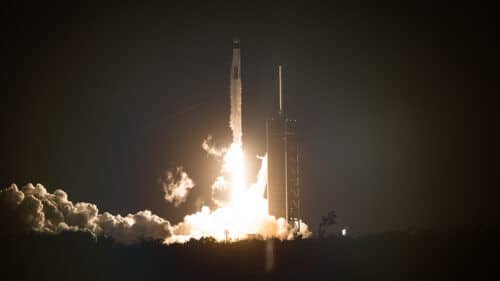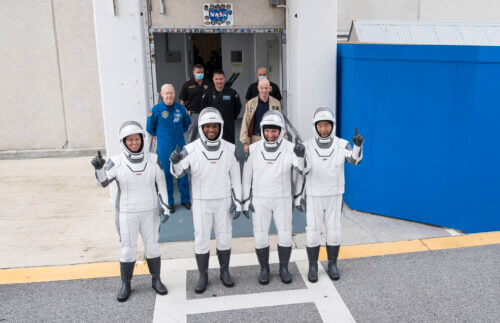
SpaceX's Falcon 9 launcher carrying the company's Crew Dragon spacecraft on NASA's CREW-1 mission and SpaceX was launched tonight to the International Space Station and inside it a spacecraft containing NASA astronauts Mike Hopkins, Victor Glover, Shannon Walker, and the Space Research Agency astronaut of Japan Soichi Noguchi, Sunday, November 15, 2020, at NASA's Kennedy Space Center in Florida. Photo: NASA/Joel Kosky
An international team of four astronauts is on its way to the International Space Station after the successful launch of the first commercial manned spacecraft in history, certified by NASA. NASA's SpaceX Crew-1 mission lifted off aboard a SpaceX Falcon 9 rocket at 19:27 EST on Sunday (02:27 Israel time Monday) from Launch Complex 39A at the agency's Kennedy Space Center in Florida .
The Crew Dragon spacecraft team includes Michael Hopkins, Victor Glover and Shannon Walker from NASA and Soichi Noguchi from the Japanese Space Agency. The four will spend six months on a scientific mission on the International Space Station.
"NASA lives up to its commitment to the American people and our international partners to deliver safe, reliable and cost-effective missions to the International Space Station through American private industry," said NASA Administrator Jim Bridsantine. "This is an important mission for NASA, SpaceX and our partners at the Japanese Space Agency, and we look forward to seeing this team arrive at the station to continue our partnership for all of humanity."
The Crew Dragon spacecraft, named Resilience, will dock autonomously in the Space Station's Harmony Module today (Monday at 23:00 p.m. EST Tuesday at XNUMX a.m. Israel time).
"I am proud of our accomplishment today," said Gavin Shotwell, president and chief operating officer of SpaceX. "Falcon 9 looks great, the Dragon arrived in orbit about 12 minutes after launch."
The Crew-1 mission is the first of six crewed missions shared by NASA and SpaceX as part of the agency's Commercial Crew program.
The mission has already registered several achievements including:
- The first flight of the commercial system approved by NASA intended for crew transportation, which is moving from the development phase to the scheduled flight phase;
- The first international crew of four to launch on an American commercial spacecraft;
- The first time the space station's permanent crew size will increase from six to seven crew members, adding additional research capability to the crew.
- The first time that the Federal Aviation Administration granted a license for the launch of a manned space flight.

Hopkins, Glover, Walker and Noguchi will join the Expedition 64 team, which includes Commander Sergey Ryzhikov and Sergey Sverchkov of the Russian Space Agency, and NASA astronaut Kate Rubin.
"It is an honor to host our astronaut as the first astronaut of the international partner participating in the ISS program," said Hiroshi Sasaki, JAXA Vice President. "We expect him to conduct many scientific experiments and demonstrate technology that will help us here on Earth. I also want to thank NASA and SpaceX for their enormous effort to make the operation a success.
Mission objectives
The crew will conduct scientific experiments and maintain the space station with science and maintenance evaluation for about six months and will return in the spring of 2021. This is planned to be the longest human space mission launched from the US. The Crew Dragon spacecraft is able to remain in orbit for at least 210 days, according to NASA's requirement.
Crew Dragon is also carrying more than 250 kg of cargo, including new scientific equipment and experiments that will test, among other things, research on the effects of improved nutrition on crew health and a student experiment designed to better understand how spaceflight affects brain function, to allow scientists to maintain The health of astronauts in long-term missions.
בין The scientific studies and research that the team will support them during the six-month mission: research using biochips containing tissues that mimic the structure and function of human organs to understand the role of microgravity on human health and translate these findings to improve human health on Earth, growing radishes in different types of light and soils As part of ongoing efforts to produce food in space, and testing a new heat removal system from NASA's next-generation spacesuit known as the Extravehicular Mobility Unit (xEMU).
During their stay in the comprehensive laboratory, several unmanned cargo spacecraft will arrive, including SpaceX's Dragon Cargo, Norton Grumman's Cygnus, as well as Boeing's Starliner CST-100 spacecraft, which is supposed to be the competing manned spacecraft, but at this stage it will arrive on an unmanned flight test flight. They will also receive two manned spacecraft - a Russian Soyuz spacecraft as well as the Crew-1 spacecraft that will bring their replacements.
At the end of the mission, the astronauts will return to Earth aboard the Dragon spacecraft which will bring them to an automatic landing at one of the seven drop sites scattered along the east coast of Florida and the Gulf of Mexico, where they will be picked up by a ship.
For information on the NASA website
More of the topic in Hayadan:
- The Crew Dragon spacecraft successfully landed in the Atlantic Ocean on the test mission * The next demonstration mission will already be manned
- The history: the first private manned launch to the space station - on Wednesday 27/5/2020
- Four NASA astronauts were selected to fly test flights of the private spacecraft

One response
Enough with the lies